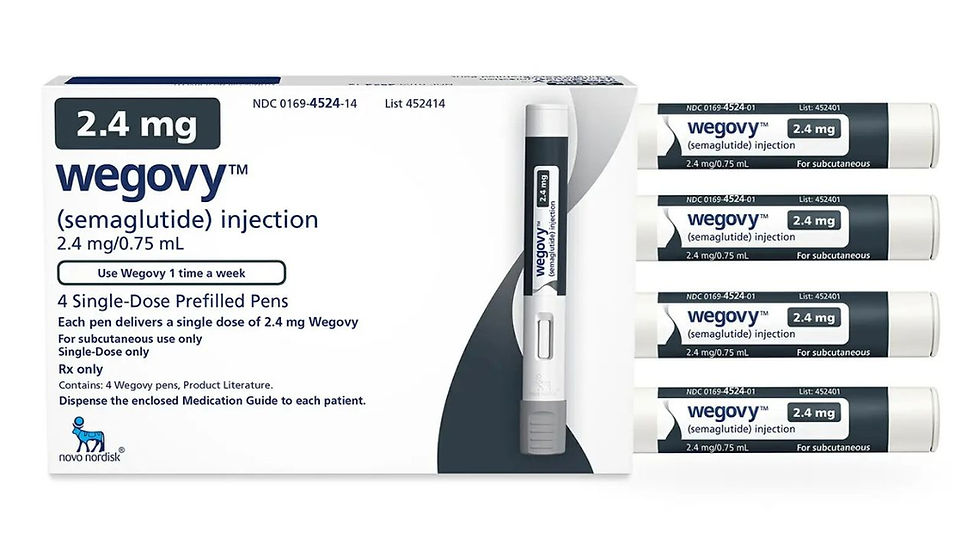What Comes After Wegovy? How One Breakthrough Is Sparking the Next Wave of Weight Loss Medications
- AJ Hill Aesthetics

- Jul 29
- 4 min read
It’s not often that a single medication reshapes an entire field, but Wegovy did just that. Since its debut, it’s changed the way we think about weight loss—not just medically, but culturally. For many, it marked a turning point: a move away from blame and toward something grounded in biology, strategy, and science.
And now that it’s proven itself on the global stage, a new wave is forming—a generation of drugs inspired by Wegovy’s success, built on similar foundations but aimed at going even further.
So what’s next? What are scientists cooking up in the labs now that Wegovy has shown what’s possible? And how different might the next round of treatments look?
From Success to Blueprint: How Wegovy Sparked a Search for More

At its core, Wegovy is a GLP-1 receptor agonist—it mimics a natural hormone that helps regulate appetite and glucose levels. But what really set it apart was how effective it turned out to be. We’re talking 15% or more in body weight loss for many people—something no previous drug had achieved consistently.
Naturally, that caught the attention of researchers, pharmaceutical companies, and biotech startups alike.
Within a few years, labs around the world began exploring how to take this foundation and build on it:
Can we create a version that works faster or lasts longer?
Can we reduce some of the side effects, like nausea or fatigue?
Can we combine GLP-1 with other mechanisms to treat a broader range of metabolic conditions?
This isn’t just about chasing profits. It’s about fine-tuning what already works and extending it to people who haven’t yet found their best-fit option.
Analogs, Derivatives, and Double Agents
If Wegovy was the starting pistol, the race that followed has brought some promising contenders into view.
Researchers are currently testing:
Dual and triple agonists that combine GLP-1 activity with other hormones like GIP (glucose-dependent insulinotropic peptide) and glucagon. These "multi-action" drugs aim to boost fat burning and appetite control simultaneously.
Extended-release formulations designed to stretch injection intervals from once a week to once a month—or even longer.
Compounds with adjusted side-effect profiles, particularly for people who experienced GI symptoms with Wegovy but still want the metabolic benefits.
One example is retatrutide, a new experimental drug that targets not one but three receptors related to metabolism. Early trial data suggest it might lead to even greater weight loss than Wegovy, though it’s still under investigation.
Another compound, CagriSema, combines the GLP-1 action with another medication, aiming to improve outcomes for people with type 2 diabetes and obesity. These aren’t just small tweaks—they’re meaningful evolutions of the original concept.
What the Experts See Coming

Dr. Nalin Persaud, a pharmacologist who studies hormone-based therapies, says Wegovy opened a door that had been closed for too long.
“For years, weight loss medications were either underwhelming or dangerous. Wegovy changed that,” he explains. “Now we’re seeing a flood of research that’s not just copying Wegovy, but asking, ‘How do we make this even smarter?’”
He points to three major directions for the next wave:
Combination therapies that target multiple pathways for more sustained results
Personalised formulations based on someone’s genetics or gut microbiome
Non-injectable options, like oral or patch-based delivery systems
Dr. Persaud believes the next five years could bring a “new class” of medications that feel less like interventions and more like support tools people can stick with long term.
Early Case Studies: What’s Already in Motion
We’re still early in this new chapter, but a few real-world examples are already making waves.
In Germany, a biotech startup is trialling a GLP-1/GIP dual-agonist specifically tailored for patients who didn’t respond well to Wegovy. So far, the early data is promising, especially in terms of lower dropout rates.
In the U.S., researchers are testing a microdose formulation that could reduce side effects while still offering steady progress—an appealing option for people with sensitive digestive systems or busy schedules.
In South Korea, a university-led program is piloting a digital + drug hybrid model, pairing newer medications with AI-based coaching to see if it boosts adherence and outcomes.
These are small case studies, not yet game-changers—but they hint at the flexibility and creativity now entering the field.
Why This Matters for You (Even If You’re Just Starting Out)
If you’re currently using Wegovy—or considering it—you might be wondering what all this future talk means for you now. The answer is: probably more than you think.
Because what Wegovy did wasn’t just launch a successful drug. It raised the standard for what’s possible in weight loss care. That means more options, better science, and more ways to get support that fits your real life—not just the standard model.
It also means you’re part of a much bigger conversation—one where researchers are listening, adjusting, and improving based on what people are experiencing every day.
This Isn’t the End of the Story—It’s the Start of a Smarter One

Breakthroughs like Wegovy don’t close the book on obesity treatment. They open the next chapter. And the fact that so many new ideas are emerging off the back of its success? That’s a good sign. It means the field is finally catching up to the complexity of real-life weight journeys.
Curious about where this research could take us next—or what it might mean for your own treatment?
We’re here to walk through it with you. Not to chase trends, but to help you make grounded, informed choices—one step at a time.






Comments